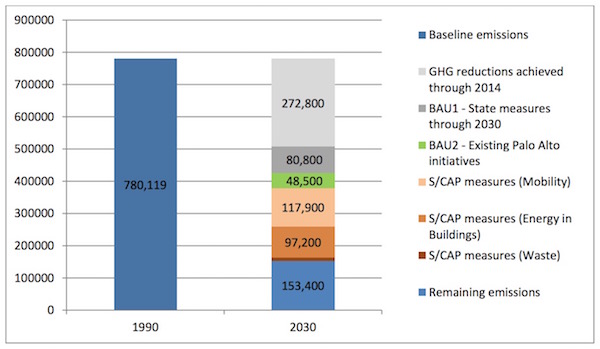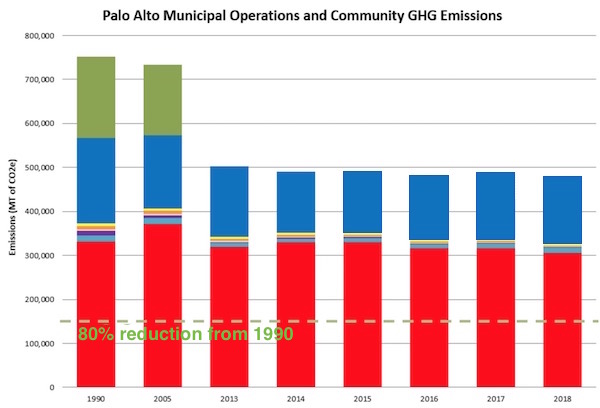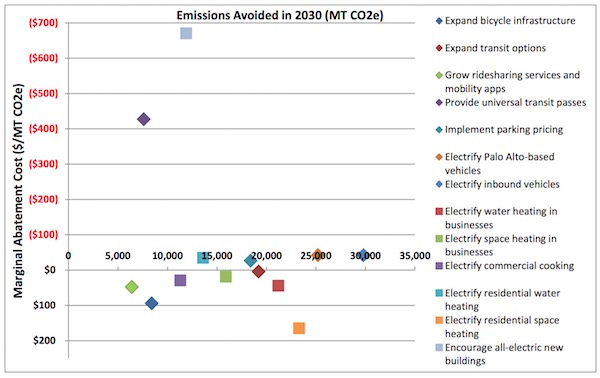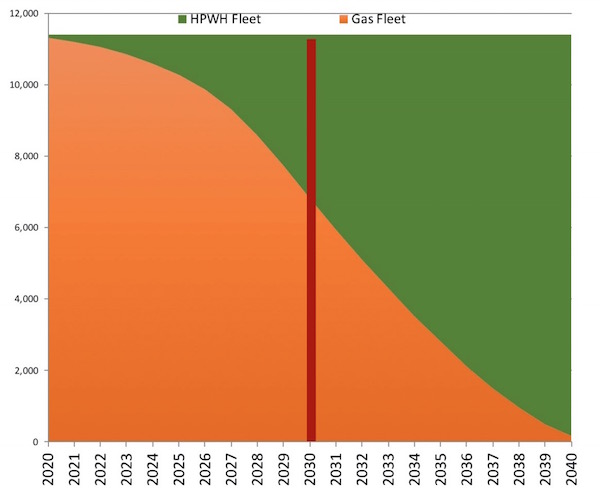Setting a Goal
On Earth Day four years ago, Palo Alto set a 2030 goal to reduce emissions 80% below 1990 levels, an impressive reach from the state’s goal of 40%. At the time, city emissions were already 35% below the 1990 baseline (2), and Palo Alto enjoys many advantages over the state at large: a city-owned utility, a temperate climate and flat terrain, a large proportion of residents with discretionary income, big eco-focused companies, and a network of local experts. So an additional 45% was targeted, shown in dark grey, green, and shades of orange below.

Palo Alto’s 2016 emissions reduction outline. Source: S/CAP Framework, 2016
Palo Alto estimated it had an additional 17% of reductions baked in (BAU = Business As Usual). Beyond that, the plan advocated another 15% from mobility emissions, 12% from building emissions, and 1% from waste emissions. A strategic plan indicated where these emissions would come from. (See page 14 of this document.)
Taking Action
In the four years since, the city has done a number of things to reduce emissions, including promoting electric cars, heaters, and appliances; updating building codes; encouraging transit and biking; installing EV charging infrastructure; and eliminating municipal incineration of sewage. Some of these efforts have been pretty successful:

In downtown Palo Alto, many more people are taking transit and fewer are driving alone. Source: Palo Alto City Staff presentation to Council, 4/13/2020
A parking garage downtown was taken off the table, and the city passed an all-electric reach code for new buildings two years ahead of schedule, with something for large remodels in the works.
Yet some initiatives have not been so successful:

Adoption of heat pump water heaters has lagged. Source: Palo Alto City Staff presentation to Council, 4/13/2020

Efficiency savings have been meager. Source: Palo Alto City Staff presentation to Council, 4/13/2020
Seeing Results?
When you sum it all up, the changes have not added up to much for the City’s emissions.

Transportation emissions (red) and natural gas emissions (blue) were unchanged from 2013 to 2018. (3) This graph does not incorporate offsets that the city is purchasing for natural gas, which we have had for the last few years. Adapted from Palo Alto City Staff presentation to Council, 4/13/2020
As Councilman Eric Filseth put it in Monday’s discussion: “It seems like we’re doing all this good stuff, and yet we’re hearing that we’re short of our goal…. Is there a giant spreadsheet somewhere that shows the quantitative relationship between where we are today and where we want to be?” Indeed, Palo Alto did a lot of analysis in 2016 to determine what would be needed to reduce our emissions. One of my favorite parts is this chart that shows the estimated cost and impact of different ways we could reduce emissions. Analysis like this was used to formulate the overall plan.

In this chart, the estimated impact of a change is on the x-axis (in metric tons of CO2e), while the estimated cost to achieve that impact is on the y-axis (with expenses in black and savings in red). Source: S/CAP Framework, 2016.
The Disconnect
So what happened? I talked with Bret Andersen, David Coale, and Bruce Hodge (Founder) of Carbon Free Palo Alto, who have been following along with the process for years. In a sense, this outcome is no surprise because the city never had a detailed plan outlining a set of actions that added up to the goal. This was due to a lack of buy-in (“I think some staff and council members believed the goal was more aspirational than achievable,” said Andersen) and political will (“We never really got staff to put the more ambitious options on the table that are required to reach 80/30,” he added). The city’s broad take on “sustainability” then diluted focus on this goal, with several stakeholders involved on projects that would have minimal impact on emissions.
The disconnect persists. There is little alignment between the city’s “80% by 2030” goal and the actions the city is proposing for the coming years. For example, Carbon Free Palo Alto estimates that we need to convert 2300 gas water heaters per year, 1400 gas HVAC systems per year, and 8600 gas vehicles per year to hit the goal. But the proposals do not add up. No one is working backwards from what the goal requires to what the city needs to get done. Hodge says “Staff is not stepping up to make proposals to achieve official policy, and Council is not stepping up to provide oversight.”
Is the city’s goal realistic? Probably not. While ambitious goals can sometimes be inspiring, unreasonable goals can also be demotivating. I don’t respond particularly well to them, and maybe that is what is happening at the city level. Certainly there is a fundamental lack of buy-in to this audacious reach, and it would behoove us to either show it can realistically be done or align everyone behind something that is more achievable. If our momentum carries us beyond any revised goal, then we can increase our ambition as California has done a few times.
Meet the New Plan
At this point, Palo Alto has hired AECOM to evaluate the city’s 2019 emissions and analyze paths forward. Some nice tools are available for modeling city emissions and generating options to reduce them. AECOM helped to develop one of the tools (CURB), and I expect their quantitative input will be useful. When
- Councilman Tom Dubois enthuses about EVs (“A big program, a media campaign, incentives, anything we can do, where we would say that nearly all replacement cars city-wide are electric…. I think that is a big goal, I think it would get attention, I think it’s something we should try.”)
- Councilman Greg Tanaka sees promise in working from home (“We are seeing across the board in companies and industry areas where it wasn’t so much the norm, but it’s being adopted successfully now.”)
- and Mayor Adrian Fine espouses infill development (“We are not going to reach our climate goals if we don't reach our housing goals. I’d encourage us all to keep that in mind.”)
we can use this kind of objective analysis to help us determine where we want to place our bets. (4)
For example, if you want to reduce annual emissions by 250 metric tons of CO2e, you might have three choices (5):
1. Replace 100 gas-powered cars with EVs.
2. Replace 300 gas-powered water heaters with electric heat pump water heaters.
3. Get 900 homes to reduce their gas use by 10%.
Which would you pick? What would it cost us to achieve these? How far can we scale these? And what side benefits, if any, accrue from doing these? EVs improve our local air quality, but they are expensive. New electric heaters also cost a significant amount up front (6), and you need to own one to change it out. Energy conservation is available to everyone (renters, low-income households, etc), but is lower impact. Which is the winning strategy, and how would you go about it?
Same as the Old Plan?
The numbers are pretty clear. Our biggest sources of emissions are transportation and heating, and we need to halve them (or more) in the next ten years. We know we need a massive switch to EVs and efficient electric heat pumps, and we would like to see a reduction in cars on the road.
So will the new plan be much different? If we are going to be successful, it better be. It should be detailed, it should be realistic, and it should add up to the goal, which may need to change. There may be some slight differences from incorporating our airport emissions and “fugitive emissions” from natural gas. There may also be some differences as we incorporate things we have learned recently, such as the value of clean air and our ability to work from home. But the overall bones of the plan will not change much. The big difference must be that everyone believes in the plan, commits to it, and evaluates progress regularly.
Several council members and community members have asked for easy-to-understand targets, like the percentage of vehicle miles that are electric, or the percentage of homes and businesses with heat pump water heaters. That makes a lot of sense. I would also like the city to focus only on those initiatives that will make a big impact on emissions. Staff has limited time and the city has limited funds, so we should use them wisely. What would I pick? For reducing transportation emissions, I would put my bets on increasing EV adoption, working from home, and co-locating jobs with housing. For reducing building emissions, I would set mandates starting in 2022 for all water heater replacements and for space heaters in large remodels. (7) I would also aggressively work with residents and local businesses to lower their gas heating bills (and gas use). And that’s it. (8) I expect we would need to be much more transparent about power reliability, and make improvements as needed. And we will need to raise money for programs if state and county funds are insufficient. Fees on actions we want to discourage would be a good start. (9) But I would limit our sights to a few things and then aim to knock them out of the park.
Palo Alto can easily over-achieve the state’s 2030 emissions goals, given where we are today (36%) and all of our advantages. AECOM’s modeling efforts will help to quantify our options. We will need to determine which approaches we can execute most cost-effectively, while also considering the value of co-benefits like cleaner air, calmer streets, increased wildlife habitat, and the improved mental and physical well-being that many of the options deliver. We have some really nice options in front of us. We just need to better connect the dots between our goal, our plan, and our execution, and make sure everyone is lined up behind them.
Earth Day (Week) Announcements
With the 50th anniversary of Earth Day coming up on April 22, you may be interested in some of these local but still virtual events. You can find an aggregation of many events around the country here.
Monday, April 20, 1:30 pm – 3:00pm. The Stanford Woods Institute for the Environment is hosting a celebration of the 50th anniversary of Earth Day. Stanford faculty and staff will share their perspectives on progress made and what governments, companies, academics and private citizens can do to give the planet and people living on it the best hope for a bright and sustainable future. (You can find more Stanford Earth Day events here.)
Wednesday April 22, 11:45 am – 1:00 pm. Green Foothills is hosting a Virtual Earth Day. Former Congressman and Earth Day Co-Founder Pete McCloskey and his wife Helen Hooper McCloskey will be the keynote speakers.
Thursday, April 23, 9am – 10am. 350 Silicon Valley Climate Action Now is hosting a "crash course" on divesting from fossil fuels. "We kick off the class with a 6-minute video of personal stories, followed by suggestions about how you can work on divestment yourself."
Friday April 24, 5:30 pm – 6:30 pm. The Peninsula Peace and Justice Center is planning a virtual Climate Rally on Friday, April 24th from 5:30-6:30pm. The Climate Rally will debut a special video presentation featuring climate experts and activists explaining what climate justice and political engagement means amidst a global pandemic and beyond.
Notes and References
1. This post is largely focused on Palo Alto, but Mountain View and Menlo Park have similar challenges. Also, this post is about reducing our carbon emissions. It is very important that we begin adapting to the changing climate as well. That includes planning for sea-level rise and reducing our reliance on fresh water. I am not covering those here, but they are both important parts of our climate planning.
2. Emissions reductions between 1990 and 2016 were largely the result of efficiency improvements and cleaner electricity.
3. For background, residential population has been flat in Palo Alto since 2005, at around 67,000, though it increased about 20% from 1990 to 2005 (it was around 56,000 in 1990). Source
4. These quotations are from the April 13 discussion on climate planning.
5. By my rudimentary calculations, an EV eliminates about 2.5 metric tons (MT) of CO2e in one year, a heat-pump water heater eliminates about 0.75 MT CO2e in one year, and a 10% reduction in a 500-therm home saves about 0.28 MT CO2e per year. The values for EVs and heat pump water heaters come from pages 35 and 37 of the city's presentation.
6. The advocacy group Carbon-Free Palo Alto, which has long been promoting initiatives to reduce our emissions, is very enthusiastic about “on-bill financing”, a method that allows the city to finance loans for electrification. Their proposed BE Smart Program outlines some ideas. The council is taking notice, with several members (e.g., Alison Cormack and Adrian Fine) urging city staff to look into on-bill financing.
7. Menlo Park produced an interesting pair of graphs that show the impact of a mandate over just relying on incentives. The first graph below shows heat pump water heater adoption when incentives are available, while the second shows adoption when a mandate is added.

With incentives, water heaters are 50% converted to electric by 2032 and 100% converted around 2040. Source: Menlo Park Climate Action Plan presentation, January 2020

With incentives and a mandate starting in 2021, water heaters are 50% converted to electric by 2026 and 100% converted by 2033. Source: Menlo Park Climate Action Plan presentation, January 2020
8. I think we will continue to grow our tree canopy, implement bike safety improvements, reduce waste, install induction cooktops, and run local buses. But I don’t think time and investment in those areas will lead to emissions reductions on the order of the items I chose to focus on. The point of planning, though, is to replace guesswork like this with evidence-based decision making.
9. Parking fees are one idea here. In the April 13 council meeting, mobility specialist Sylvia Star-Lack, who worked on Stanford’s driving reduction program, said “The reason that (Stanford) program worked so well is because the parking is price corrected.”
10. I was generally encouraged by the discussion in city council, but was very disappointed in one comment from a council member: “I am wondering if this plan isn’t a little like losing weight, where you start out with a big bang and you lose all that weight, and then forever more you are trying to lose that 5-10 pounds.” That analogy alarms me. This is not like losing the last 5-10 pounds. If we want to liken our predicament to a diet, the situation imo is more like a morbidly obese and ailing 400-pound person who has been told to lose half their body weight or they will become gravely ill. They have given up dessert and red meat and lost 60 pounds, but they have so much left to do (exercise, portion control, balanced meals, …). Our city has taken some essential steps, but we have a long way yet to go, while the Earth continues to heat up.
Current Climate Data (March 2020)
Global impacts, US impacts, CO2 metric, Climate dashboard (updated annually)
Last month was the globe’s second warmest March in the 141-year NOAA global temperature dataset record. Only 2016 was warmer. But we did not feel it where we live.

Comment Guidelines
I hope that your contributions will be an important part of this blog. To keep the discussion productive, please adhere to these guidelines, or your comment may be moderated:
- Avoid disrespectful, disparaging, snide, angry, or ad hominem comments.
- Stay fact-based and refer to reputable sources.
- Stay on topic.
- In general, maintain this as a welcoming space for all readers.



